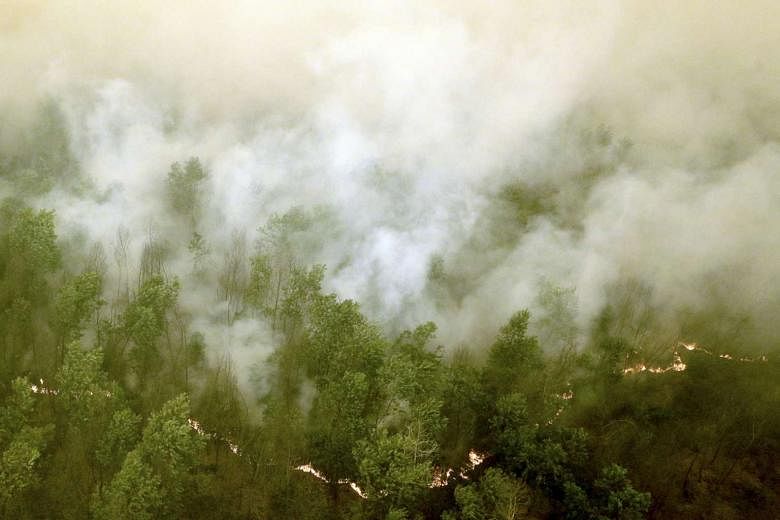JAKARTA (AFP) - Indonesian forest and agricultural fires cloaking South-east Asia in acrid haze are spewing more greenhouse gases into the atmosphere each day than all United States economic activity, according to an environmental watchdog.
The shock assessment came as Jakarta said the number of blazes was increasing across the archipelago despite a multinational fire-fighting effort, and announced plans to deploy more water-bombing aircraft.
For nearly two months, thousands of fires caused by slash-and-burn farming have suffocated vast expanses of South-east Asia with haze, causing respiratory illnesses to soar, schools to close, and scores of flights and some international events to be cancelled.
Much of the burning is in tropical peatlands rich in carbon but which are being drained and cleared at a rapid rate to make way for agriculture, particularly fast-expanding palm oil plantations.
The World Resources Institute (WRI), using findings from the Global Fire Emissions Database, said in a recent report that since early September carbon emissions from the fires had exceeded average US daily output on 26 out of 44 days.
The United States is the world's second-largest greenhouse gas source after China.
The WRI, a US-based research organisation that focuses on environment and development issues, normally classifies Indonesia as the fifth-biggest emitter.
"The burning of tropical peatlands is so significant for greenhouse gas emissions because these areas store some of the highest quantities of carbon on Earth, accumulated over thousands of years," the WRI, which used findings from the Global Fire Emissions Database for the report, said.
"Draining and burning these lands for agricultural expansion, such as conversion to oil palm or pulpwood plantations, leads to huge spikes in greenhouse gas emissions."
The fires and resulting region-wide blanket of smoke occur to varying degrees each year during the dry season as land is illegally cleared by burning, regularly angering Indonesia's smog-hit neighbours Malaysia and Singapore.
Malaysia, which in recent weeks has repeatedly ordered school closures across several states as a health precaution, did so again on Wednesday for the third-straight day as pollution levels climbed.
Air quality was in the "very unhealthy" range near the capital Kuala Lumpur under the government's rating system, with much of the rest of the country experiencing "unhealthy" air.
In Singapore, air quality was also in the "unhealthy" range.
Popular Thai holiday islands have also been affected, with the haze forcing several planes packed with beach-bound tourists to turn back earlier this month.
Experts warn the current outbreak is on track to become the worst ever, exacerbated by bone-dry conditions caused by the El Nino weather phenomenon.
The fires on the huge islands of Sumatra and Borneo are typically only brought under control by November with the onset of the rainy season.
But Mr Herry Purnomo, a scientist at the Indonesia-based Centre for International Forestry Research, told AFP this week that climatology data indicated the rainy season may be delayed this year and that the fires could last until year-end.
Indonesia earlier this month agreed to accept international help after failing for weeks to douse the fires manually and last week launched its biggest fire-fighting push yet.
But the national disaster agency said that the number of "hotspots" - areas detected by satellite which are already ablaze, or are extremely hot and ripe to go up in flames - had risen to more than 3,200 across the archipelago.
As well as on Sumatra and the Indonesian part of Borneo, a substantial number had been detected in the easternmost region of Papua, the agency said.
Papua is not typically affected by widespread outbreaks of agricultural fires.
At a Cabinet meeting late on Tuesday, the government decided it needs another 10 to 15 water-bombing planes, which it plans to rent from international allies, agency spokesman Sutopo Purwo Nugroho said.
About 30 planes are currently involved in water-bombing and artificially inducing rain, with Singaporean and Malaysian aircraft having taken part. Two Russian planes were due to arrive later Wednesday to provide assistance.

